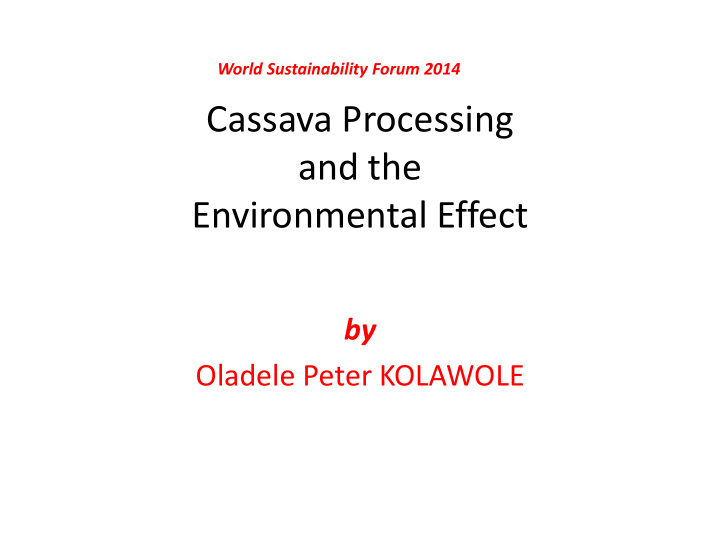



World Sustainability Forum 2014 Cassava Processing and the Environmental Effect by Oladele Peter KOLAWOLE
INTRODUCTION • Cassava ( Manihot esculenta Crantz) is a very important food crop that is capable of providing food security.
• Cassava roots can be converted through processing into enough food. • Machine application for cassava roots processing has helped greatly to add value, leading to profit making and provision of food.
• The farmer at the village level depends on the sun for drying of cassava products. • They obtain firewood from forests and use fossil fuel from petroleum to power the tractor and small internal combustion engine (ICE).
• In traditional operations, fermentation and pressing (de-watering) are done in one operation. • Gari frying and flour drying are complex procedures. • Operators are exposed to heat and smoke from the fire.
Waste water from cassava processing, when released directly into the environment causes pollution . These activities affects the environment.
• This type of environmental pollution required resources to control • The foul odour can lead to contamination of surface and underground water. • From the investigation, fossil fuels have the biggest historical and present share of polluting emissions. They contributes directly to global warming.
• Firewood consumption in cooking and processing gari could lead to severe deforestation and desertification.
Cassava processing activities like any other industry have its own share in emitting greenhouse gases that can be responsible for global warming. The level of atmospheric carbon dioxide (CO 2 ) affect both water availability and demand, through its influence on vegetation. • It is widely accepted that the increasing concentration of greenhouse gases in the atmosphere is altering the earth's radiation balance and causing the temperature to rise.
Effluent water and dangerous gases produced by cassava processing centres required better handling. The work of Omotioma et al 2013. Below confirm this . IMPACT ASSESSMENT OF CASSAVA EFFLUENTS ON BARIKA STREAM IN IBADAN, NIGERIA Table 1 Physicochemical Properties of the Polluted Barika Stream in Ibadan Nigeria • Omotioma M., Mbah G. O., Akpan I. J. and Ibezim O. B. / International Journal of Environmental Science, Management and Engineering Research Vol. 2 (2), pp. 50-56, Mar-Apr, 2013. Available on-line at http:// www.ijesmer.com
• Attempts was made by IITA to correct effluent creating a safe discharge • The use of cleaner fuel was proposed to lower the generation of carbon dioxide in farms • Processors need to think of better way by balancing the resources and climate.
CONCLUSIONS Effective strategies that will enhance the livelihood opportunities of the rural • poor must be sustained for the ecosystem services. Cassava processing must be designed to increase economic, social, and • ecological resilience to climate change. Cassava processors need to adopt the use of clean energy to prevent the • effects of global warming. New forms of energy development and nature conservation that are climate- • friendly are needed in factories. Emissions of CO 2 and other greenhouse gases must be controlled. • Use of firewood for cooking and processing food must be prohibited to • reduce deforestation. Mankind is expected to respond to these effects by taking adaptive • measures including changing patterns of cooking and drying. Cassava processors must reduce environmental pollution at all costs. •
Recommend
More recommend